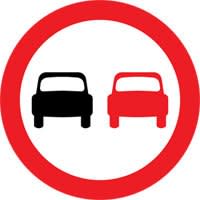Overtaking is something which you probably won’t have done a great deal of during your driving lessons, but it’s important to know how to do it safely. There may be times when you need to overtake a slow moving vehicle, cyclist or horse rider, but this can be a risky manoeuvre if you don’t know when it’s safe to do so.
How do I know when it’s safe to overtake?
Whether or not it’s safe to overtake depends upon a number of factors. For example, whether you can see far enough in front, what the road markings are and what’s coming up on the road ahead are are all important factors.
Although being able to show you can overtake safely isn’t something you’re assessed on in the driving test, you might find yourself in a situation where it’s necessary to do so. If, for example, there is a slow moving vehicle or a cyclist in front of you, you’ll need to get past them in order to avoid long tailbacks, but only if it is safe do so.
Being able to determine whether or not it’s safe to overtake is very important, because getting it wrong could put you and others at risk. It’s not just a case of making sure there’s no oncoming traffic ahead, as you’ll need to be aware of what the road markings mean and whether there are any junctions, turnings, bends or hidden dips coming up ahead.
In order to know if it’s safe to overtake, you’ll need to be able to analyse all of these factors before making a judgement.
Do NOT overtake if:
- There is an oncoming vehicle.
- There is a bend, hidden dip or brow of a hill ahead.
- There is a ‘no overtaking’ sign.
- There is a junction, side road or pedestrian crossing ahead.
Finally, if in doubt, do not overtake until you are 100% sure it’s safe to do so.

Know your road markings
Overtaking on a single carriageway involves more hazards than overtaking on a motorway or dual carriageway. Not only will there be traffic coming in the opposite direction, but road markings will also dictate when you are able to overtake and when you should avoid crossing on to the other side of the road.
A broken white line: It is okay to overtake on a broken white line as long as you’re sure it is safe to do so.
Double white lines where the line nearest you is broken: You are able to overtake as long as it is safe to do so. Oncoming traffic is not allowed to overtake and enter your side of the carriageway.
Double white lines where the line nearest you is solid: You are not allowed to overtake unless it is safe to do so and you’re passing a bicycle, horse or road maintenance vehicle traveling at 10mph or less. You may also cross this white line if you’re turning into an adjoining premises or side road.
White diagonal stripes or chevrons: These are used to separate lanes or protect traffic turning right. If the marked area has a broken white line border, you should only enter it if absolutely necessary and if it is safe to do so.
Solid white lines: If the area is bordered by a solid white line you should not enter it unless it is an emergency.
White direction arrows: These when painted on the road signal that you need to get back on to your side of the road after you have overtaken a vehicle, cyclist or horse.
Overtaking large vehicles
Overtaking a large vehicle like a lorry or a tractor can be be tricky because it’s hard to see around them.
If you’re trying to overtake a large vehicle, drop back, giving yourself plenty of room to see around them at what’s coming in the other direction. You will need to make sure you drop back enough to ensure there’s no vehicles in front of the vehicle you’re trying to overtake.
Remember that overtaking a large vehicle will take longer than overtaking a car or cyclist. Make sure, before you commit to overtaking, that you have enough room to complete the manoeuvre safely and that you do not pull in too close to the front of the vehicle. Check your left side mirror before pulling back into lane to make sure you have left enough room between yourself and the vehicle you have overtaken.
Overtaking, motorbikes bicycles and horses
Cyclists, motorcyclists and horse riders are vulnerable road users, and you need to give them the same amount of space and courtesy that you would when overtaking a vehicle. You should leave 1metre to 1.5metres between your car and the road user you are overtaking. Ensure you only overtake when it is safe to do so and there are no oncoming vehicles.
Be aware that motorcyclists and cyclists may need to avoid potholes or wet patches on the road, and, if they look over their shoulder or signal that they are turning right, do not overtake.
Take a look at our infographic on how to drive around cyclists for some more tips on overtaking safely.
The same rules apply to horse riders. Be very careful when approaching and overtaking a horse rider. Slow down and leave plenty of room before and whilst you overtake. Wait until you have enough time to do so as driving too quickly or too close might spook the horse.
Mirror, signal manoeuvre
Once you have decided that it’s safe to overtake, you need to complete the mirror, signal, manoeuvre procedure before committing to overtaking.
- Check your rear and side view mirrors to ensure it’s clear to pull out.
- Signal to make other drivers aware of your intentions.
- Pull out and overtake if safe to do so.